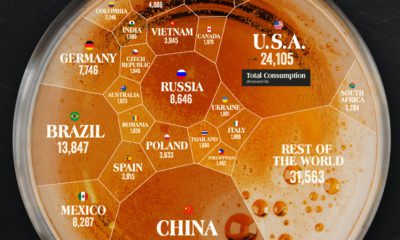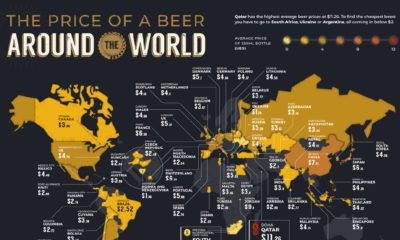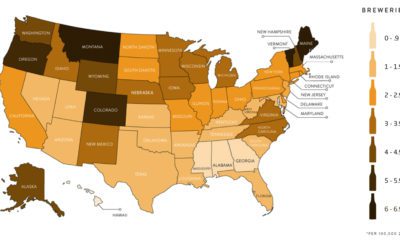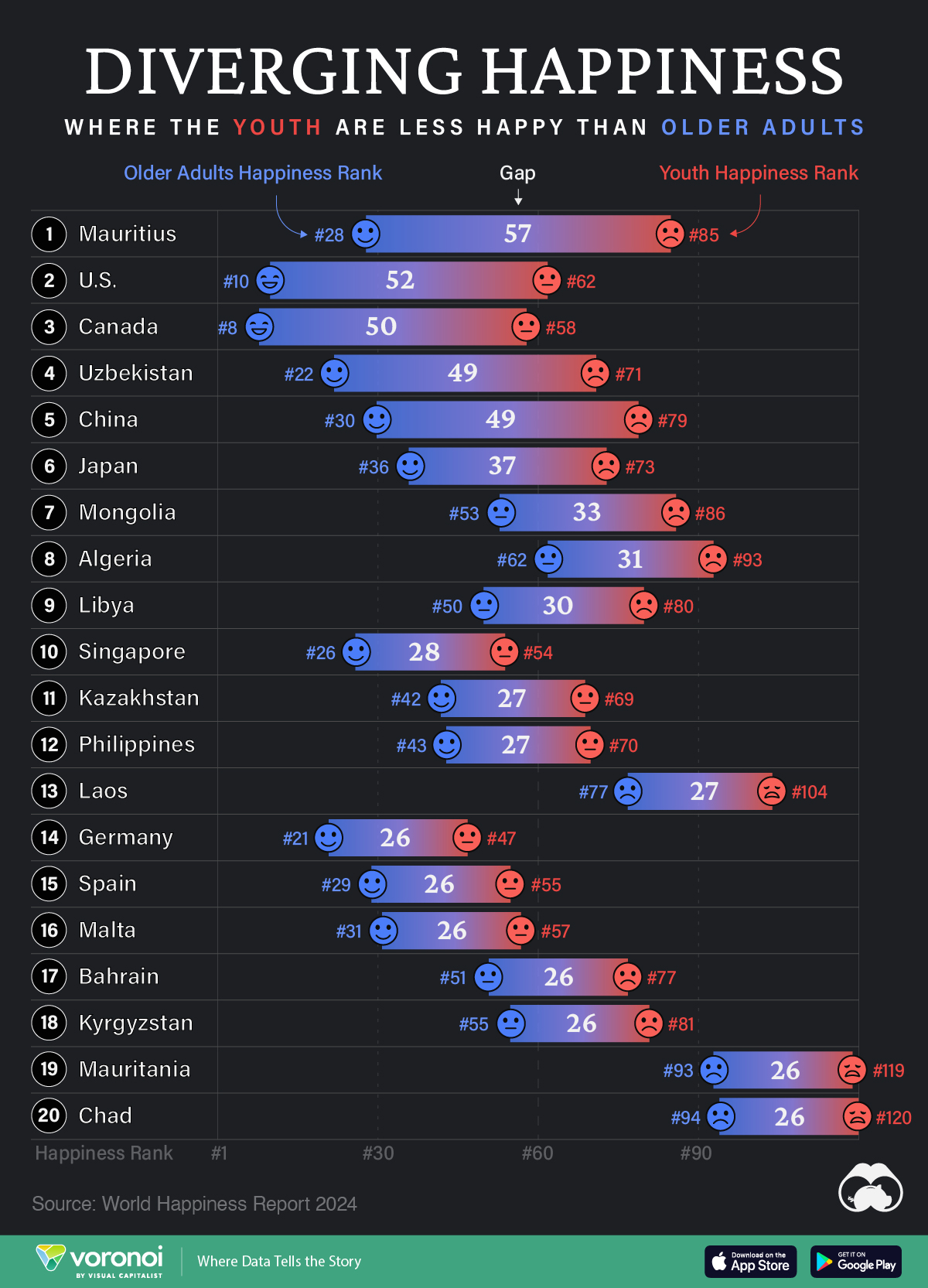Culture
Ranked: Which Countries Drink the Most Beer?
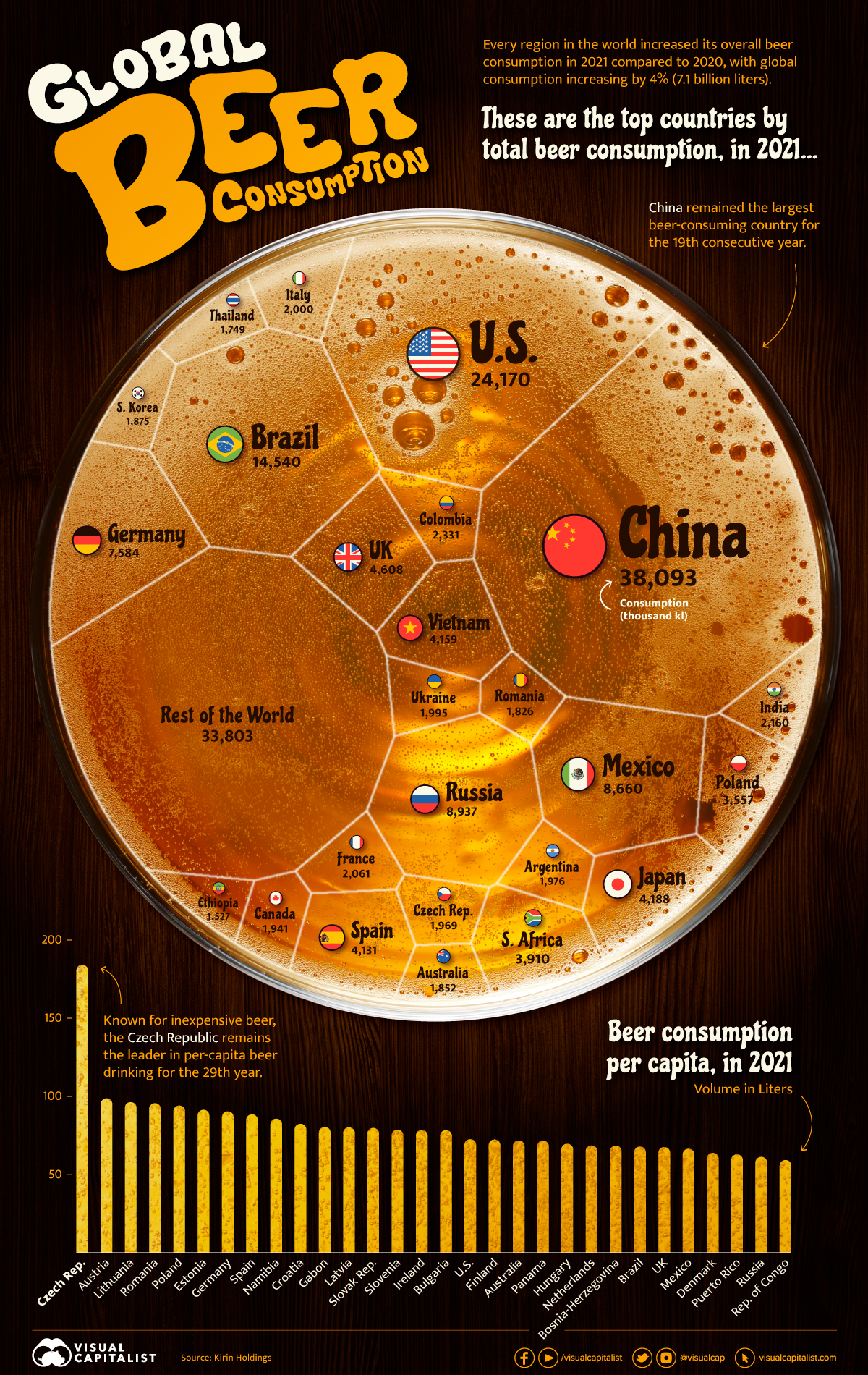
Visualizing Global Beer Consumption
Global beer consumption exceeded 185 million kiloliters in 2021, enough to fill more than 74,000 Olympic-sized swimming pools.
So, which countries drink the most beer?
This graphic uses data from Kirin Holdings to compare global beer consumption by country. The Japanese company has been tracking beer consumption around the world since 1975.
Which Countries Drink the Most Beer?
Every region in the world increased its overall beer consumption in 2021 compared to 2020, with global consumption rising by 4%.
Asia holds a 31% share of the global beer market, remaining the world’s largest beer-consuming region over the last 14 years.
| Rank | Country | Total Consumption (thousand kl) | Market Share |
|---|---|---|---|
| 1 | 🇨🇳 China | 38,093 | 20.5% |
| 2 | 🇺🇸 U.S. | 24,170 | 13.0% |
| 3 | 🇧🇷 Brazil | 14,540 | 7.8% |
| 4 | 🇷🇺 Russia | 8,937 | 4.8% |
| 5 | 🇲🇽 Mexico | 8,660 | 4.7% |
| 6 | 🇩🇪 Germany | 7,584 | 4.1% |
| 7 | 🇬🇧 United Kingdom | 4,608 | 2.5% |
| 8 | 🇯🇵 Japan | 4,188 | 2.3% |
| 9 | 🇻🇳 Vietnam | 4,159 | 2.2% |
| 10 | 🇪🇸 Spain | 4,131 | 2.2% |
China was the largest beer-consuming country for the 19th consecutive year.
The tradition of brewing and enjoying beer in China spans approximately nine millennia. Recent archaeological discoveries have revealed that as far back as 7000 BC, ancient Chinese communities were engaged in producing beer-like alcoholic beverages, primarily on a small and localized basis.
China was also the leading producer of beer in 2022, followed by the United States.
Beer Consumption Per Capita
When examining per capita beer consumption, Asia falls behind Europe. In fact, nine of the top 10 consumers of beer per capita are European nations.
The Czech Republic remains the leader in per capita beer drinking for the 29th year. In 2021, the average Czech drank more than 184 liters of beer.
| Rank | Country | Per Capita Beer Consumption (volume in liters) | Total Consumption (thousand kl) |
|---|---|---|---|
| 1 | 🇨🇿 Czech Republic | 184.1 | 1,969 |
| 2 | 🇦🇹 Austria | 98.7 | 888 |
| 3 | 🇱🇹 Lithuania | 96.3 | 260 |
| 4 | 🇷🇴 Romania | 95.6 | 1,826 |
| 5 | 🇵🇱 Poland | 94.1 | 3,557 |
| 6 | 🇪🇪 Estonia | 91.4 | 119 |
| 7 | 🇩🇪 Germany | 90.4 | 7,584 |
| 8 | 🇪🇸 Spain | 88.5 | 4,131 |
| 9 | 🇳🇦 Namibia | 85.7 | 223 |
| 10 | 🇭🇷 Croatia | 82.4 | 338 |
The Czech Republic is known for its affordable beer. In some parts of the country, beer can even cost less than bottled water.
Small Brewers and Technology
Beer production is expected to rise over the next decade, boosted by new smaller brewers, particularly in Western countries.
Investments have also been made in new technology to expedite the brewing process, including the utilization of ‘BeerBots’ capable of accelerating the fermentation process.
According to Future Market Insights, the global beer market is projected to be valued at $690 billion in 2023, rising to $996 billion by 2033.
Demographics
Ranked: Countries Where Youth are the Most Unhappy, Relative to Older Generations
Conventional wisdom says that young adults (those below 30) tend to be the happiest demographic—but this is not true for these countries.
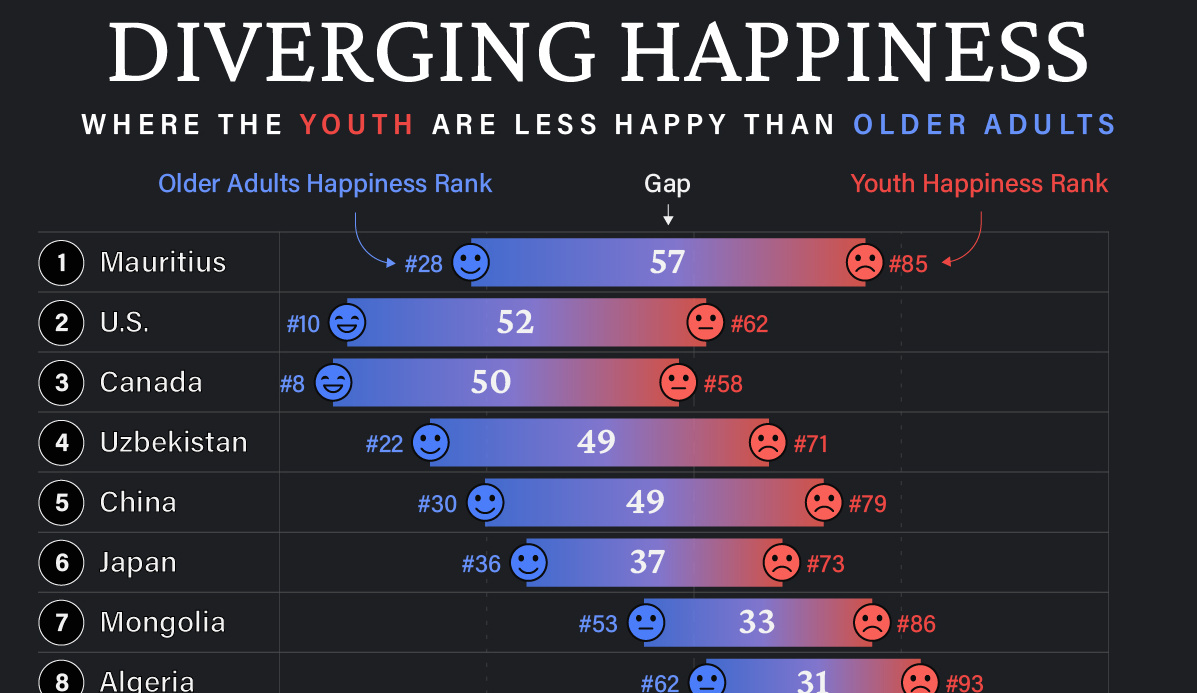
Countries with the Biggest Happiness Gaps Between Generations
This was originally posted on our Voronoi app. Download the app for free on iOS or Android and discover incredible data-driven charts from a variety of trusted sources.
“They say a person needs just three things to be truly happy in this world: someone to love, something to do, and something to hope for.” — Tom Bodett
Measuring happiness is tricky business, more so when taking into account how different regions, cultures, and faiths define it. Nevertheless, the World Happiness Report attempts to distill being happy into a single score out of 10, and then ranks countries by their average score.
We’ve visualized the high-level findings from the latest happiness report in this series of maps. However, the report also dives deeper into other significant trends in the data, such as a growing disparity in happiness between age groups within countries themselves.
In the chart above, we list countries by the biggest gaps in happiness ranks between young adults (<30) and older adults (60+). A higher number indicates a larger gap, and that the youth are far unhappier than their older counterparts.
Where are Youth Unhappier than Older Adults?
Mauritius ranks first on this list, with a massive 57 place gap between older adult and youth happiness. The 1.26 million-inhabited island nation briefly reached high income status in 2020, but the pandemic hit hard, hurting its key tourism sector, and affecting jobs.
The country’s youth unemployment rate spiked to close to 25% that year, but has since been on the decline. Like residents on many similarly-populated islands, the younger demographic often moves abroad in search of more opportunities.
| Rank | Country | Youth Happiness Rank | Older Adult Happiness Rank | Happiness Gap |
|---|---|---|---|---|
| 1 | 🇲🇺 Mauritius | 85 | 28 | 57 |
| 2 | 🇺🇸 U.S. | 62 | 10 | 52 |
| 3 | 🇨🇦 Canada | 58 | 8 | 50 |
| 4 | 🇺🇿 Uzbekistan | 71 | 22 | 49 |
| 5 | 🇨🇳 China | 79 | 30 | 49 |
| 6 | 🇯🇵 Japan | 73 | 36 | 37 |
| 7 | 🇲🇳 Mongolia | 86 | 53 | 33 |
| 8 | 🇩🇿 Algeria | 93 | 62 | 31 |
| 9 | 🇱🇾 Libya | 80 | 50 | 30 |
| 10 | 🇸🇬 Singapore | 54 | 26 | 28 |
| 11 | 🇰🇿 Kazakhstan | 69 | 42 | 27 |
| 12 | 🇵🇭 Philippines | 70 | 43 | 27 |
| 13 | 🇱🇦 Laos | 104 | 77 | 27 |
| 14 | 🇩🇪 Germany | 47 | 21 | 26 |
| 15 | 🇪🇸 Spain | 55 | 29 | 26 |
| 16 | 🇲🇹 Malta | 57 | 31 | 26 |
| 17 | 🇧🇭 Bahrain | 77 | 51 | 26 |
| 18 | 🇰🇬 Kyrgyzstan | 81 | 55 | 26 |
| 19 | 🇲🇷 Mauritania | 119 | 93 | 26 |
| 20 | 🇹🇩 Chad | 120 | 94 | 26 |
Conventional wisdom says, and data somewhat correlates, that young adults (those below 30) tend to be the happiest demographic. Happiness then decreases through middle age and starts increasing around 60. However, the above countries are digressing from the pattern, with older generations being much happier than young adults.
That older generations are happier, by itself, is not a bad thing. However, that younger adults are so much unhappier in the same country can point to several unique stresses that those aged below 30 are facing.
For example, in the U.S. and Canada—both near the top of this list—many young adults feel like they have been priced out of owning a home: a once key metric of success.
Climate anxieties are also high, with worries about the future of the world they’ll inhabit. Finally, persistent economic inequities are also weighing on the younger generation, with many in that cohort feeling like they will never be able to afford to retire.
All of this comes alongside a rising loneliness epidemic, where those aged 18–25 report much higher rates of loneliness than the general population.
Source: The World Happiness Report which leverages data from the Gallup World Poll.
Methodology: A nationally representative group of approximately 1,000 people per country are asked to evaluate their life on a scale of 0–10. Scores are averaged across generations per country over three years. Countries are ranked by their scores out of 10.
-

 Personal Finance1 week ago
Personal Finance1 week agoVisualizing the Tax Burden of Every U.S. State
-

 Misc6 days ago
Misc6 days agoVisualized: Aircraft Carriers by Country
-

 Culture6 days ago
Culture6 days agoHow Popular Snack Brand Logos Have Changed
-

 Mining1 week ago
Mining1 week agoVisualizing Copper Production by Country in 2023
-

 Misc1 week ago
Misc1 week agoCharted: How Americans Feel About Federal Government Agencies
-

 Healthcare1 week ago
Healthcare1 week agoWhich Countries Have the Highest Infant Mortality Rates?
-

 Demographics1 week ago
Demographics1 week agoMapped: U.S. Immigrants by Region
-

 Maps1 week ago
Maps1 week agoMapped: Southeast Asia’s GDP Per Capita, by Country





